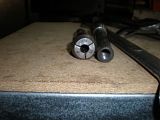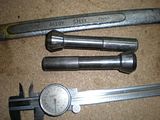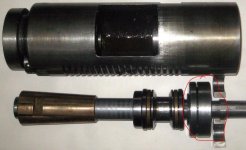Rudd
Stainless
- Joined
- Jul 30, 2003
- Location
- savannah, jaw-ja
I just got the mill shown on the forks into my shop. I am looking for any info, a parts breakdown would be great. It appears to be in good to very good but very dirty condition, so I am not planning on tearing it down. I did find a nice patch of babys**t green paint under the added on start switch, so I may have the color decided!
Click on thumbnails to enlarge.
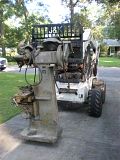
Tony's lathes uk site shows a newer model - I've ganked some images to illustrate my questions.
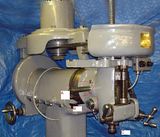
Shaft at "A" is approx. 1" dia, has a left hand thread, and will protrude on the opposite side of the head when screwed it. I cannot determine what it does.
Collared shaft at "B" does not go completely through the head, again, what is it's function? Split collar is threaded on with an SHCS to lock it. Possibly a bushing adjuster? Early models had a partially split bronze bush at the lower end of the spindle according to the lathes uk site.
At "C" I have a hex nut that will rotate about 30 degrees either way - then hits what feels like a hard stop. It does not lock the collet in place. Machine uses 3C collets. Mine looks more like the B&W image than the photo of the nicely painted machine. I can't feel anything happening inside the spindle at the collet seat when this nut is turned. I don't want to force it.
Above this is a LARGE knurled collar at the bottom of the head which I suspect retains the spindle vertically, i.e., it looks like the spindle comes out through the bottom of the head.

And finally, the later model mill had a capstan rack and pinion arrangement to slide the massive ram in and out. Mine does not. I've gotten mine to move just a skoch by prying, but it looks like it would take Popeye to move this in and out on a regular basis.
Things are beginning to free up some with liberal application of the magic fluid (oil) - the machine had been sitting 24 years or so in a garage. The ram looks like a poser though.
I got the original motor (British made Newman) which has no info other than the maker. I have no idea what voltage it might want. There's a Westinghouse 220/3ph on it right now. A VFD is in my immediate future either way, so if I can figure out the brit motor, I might reinstall.
Thanks
Rudd
Thanks
Rudd
Click on thumbnails to enlarge.

Tony's lathes uk site shows a newer model - I've ganked some images to illustrate my questions.

Shaft at "A" is approx. 1" dia, has a left hand thread, and will protrude on the opposite side of the head when screwed it. I cannot determine what it does.
Collared shaft at "B" does not go completely through the head, again, what is it's function? Split collar is threaded on with an SHCS to lock it. Possibly a bushing adjuster? Early models had a partially split bronze bush at the lower end of the spindle according to the lathes uk site.
At "C" I have a hex nut that will rotate about 30 degrees either way - then hits what feels like a hard stop. It does not lock the collet in place. Machine uses 3C collets. Mine looks more like the B&W image than the photo of the nicely painted machine. I can't feel anything happening inside the spindle at the collet seat when this nut is turned. I don't want to force it.
Above this is a LARGE knurled collar at the bottom of the head which I suspect retains the spindle vertically, i.e., it looks like the spindle comes out through the bottom of the head.

And finally, the later model mill had a capstan rack and pinion arrangement to slide the massive ram in and out. Mine does not. I've gotten mine to move just a skoch by prying, but it looks like it would take Popeye to move this in and out on a regular basis.
Things are beginning to free up some with liberal application of the magic fluid (oil) - the machine had been sitting 24 years or so in a garage. The ram looks like a poser though.
I got the original motor (British made Newman) which has no info other than the maker. I have no idea what voltage it might want. There's a Westinghouse 220/3ph on it right now. A VFD is in my immediate future either way, so if I can figure out the brit motor, I might reinstall.
Thanks
Rudd
Thanks
Rudd
Last edited:



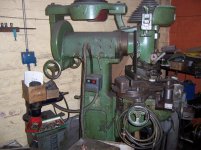

 Again, click on thumbnails to enlarge. A 3c has threads on the OUTSIDE from any I have seen offered for sale.
Again, click on thumbnails to enlarge. A 3c has threads on the OUTSIDE from any I have seen offered for sale. 